
When I asked chef Hugh Acheson if this recipe had a backstory, he laughed at me and said, "Hell no. Food's not that complicated."
Maybe it's this mentality that allows the chef to to run four very successful restaurants in his home state of Georgia, appear as an occasional judge or contestant on Top Chef, travel the country to promote his newest cookbook The Broad Fork and be super chill, charming, and kind.
That idea that food should be simple is important to Acheson, and he emphatically believes that cooking should be taught as a basic life skill.
"I'm working on this big re-do of home economics in the state of Georgia," Acheson said. The program will focus on teaching middle school students things like sewing (which, Acheson said, he's actually very good at) and how to prepare simple foods from scratch. "One of the core things is teaching kids how to poach an egg," he said, which is a simple thing that nobody can seem to get quite right.
You'll notice that the basic steps of this recipe — blanch a green vegetable, roast meat, toast bread, toss a simple salad, poach an egg — are precisely the "not-that-complicated" skills that Acheson is trying to teach.
Here is everything you will need to cook this breakfast:

1. Start by filling a large saucepan 3/4 of the way with water, then season the water with 1-2 tablespoons of salt and bring it to a boil over high heat.

2. While the water heats, remove the fava beans from their pods.

This is an infamous task that you will remember every time you eat another fava bean.

3. You should end up with about 2 cups of favas.
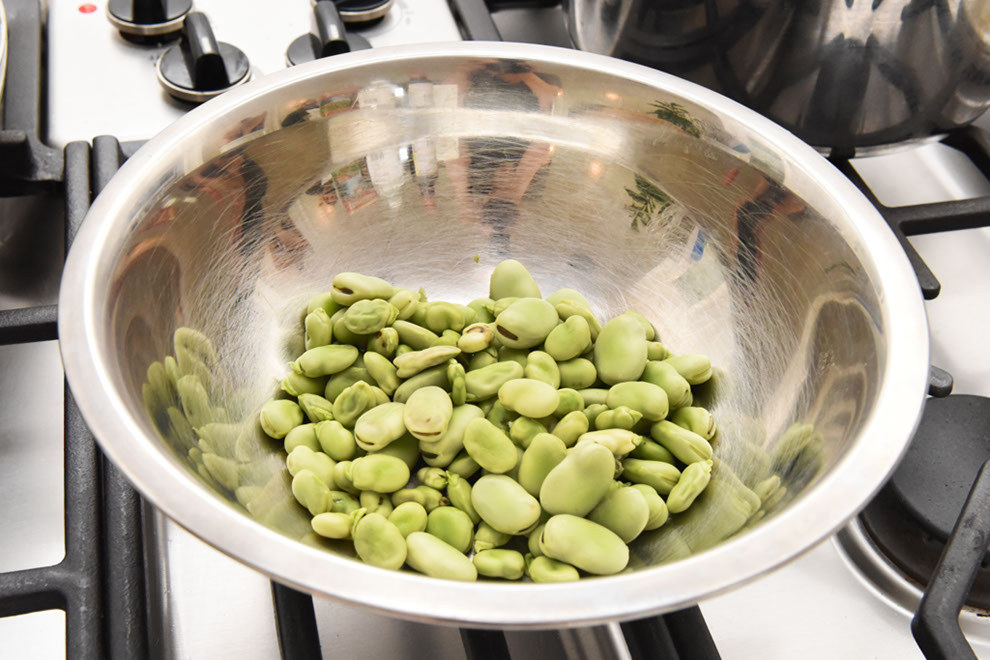
4. Before you blanch the fava beans in the boiling water, set up an ice water bath by filling a medium mixing bowl almost all the way with half ice and half water.

5. Drop the fava beans in the boiling water all at once.

6. Boil them for about a minute then test one to see if it's bright green on the inside but still al dente.


Test by picking one up out of the water after a minute, dropping it in the ice bath for a second to cool it just enough to handle, and peeling the outer layer. The bean inside should be bright green.
7. Use a strainer to pick the beans up out of the water.
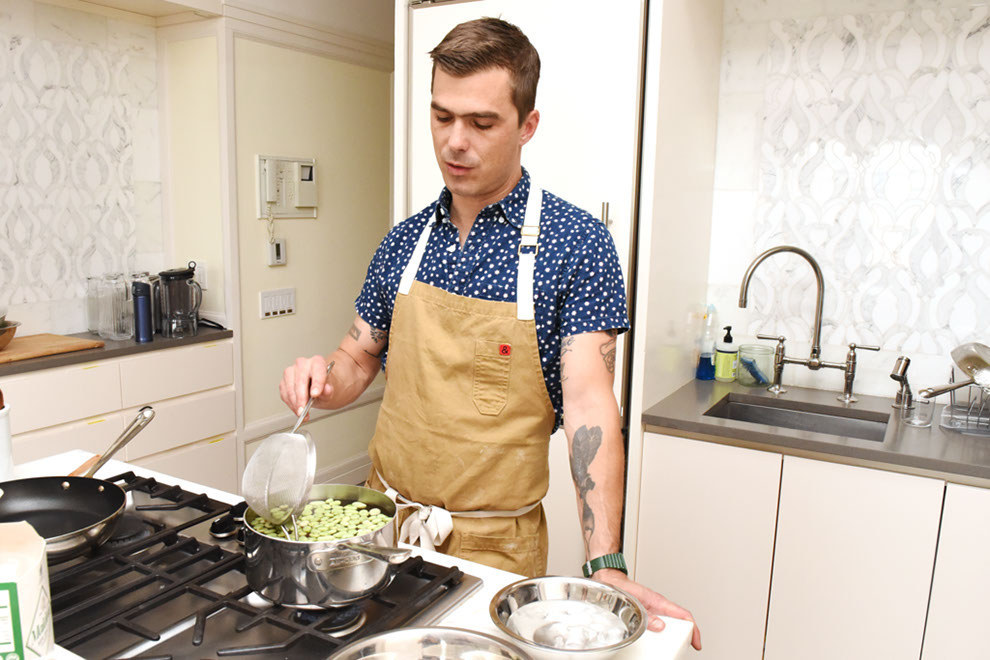
8. Drop them into the ice bath and let them sit for a minute.
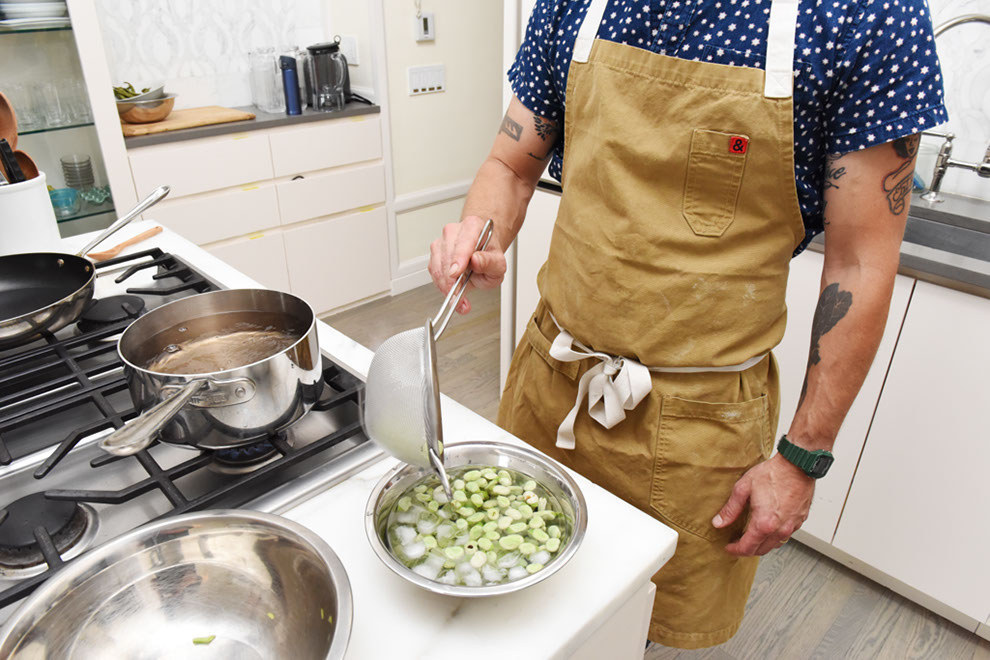
9. Gently peel the pale outer layer off and discard. You'll be left with bright green beans. When all the beans are peeled, set them aside.

10. Preheat the oven to 350°F and lay the pancetta out on a baking sheet.

11. Bake the pancetta for 10-12 minutes.

12. While the pancetta cooks, thinly slice the bread. You'll need at least 4 slices.
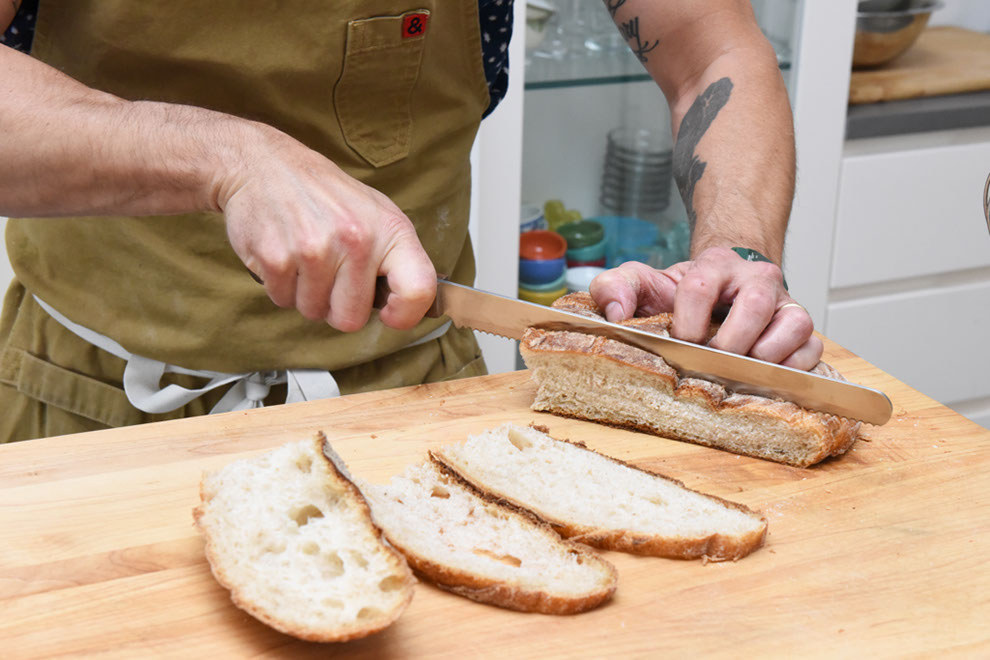
13. Line another baking sheet with parchment paper, drizzle it with olive oil, and lay the slices of bread down on the sheet.
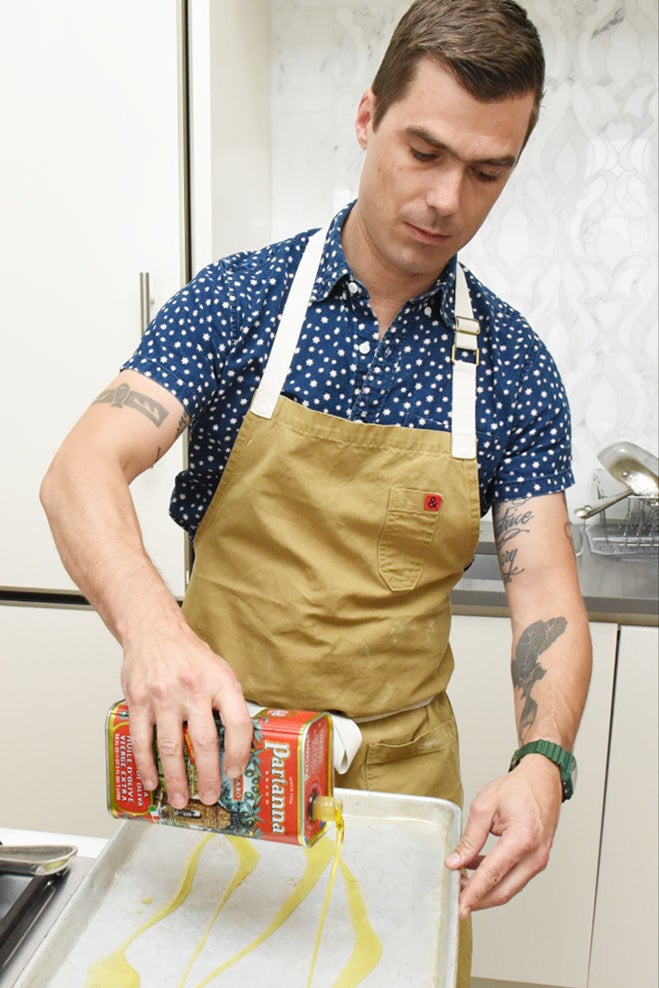
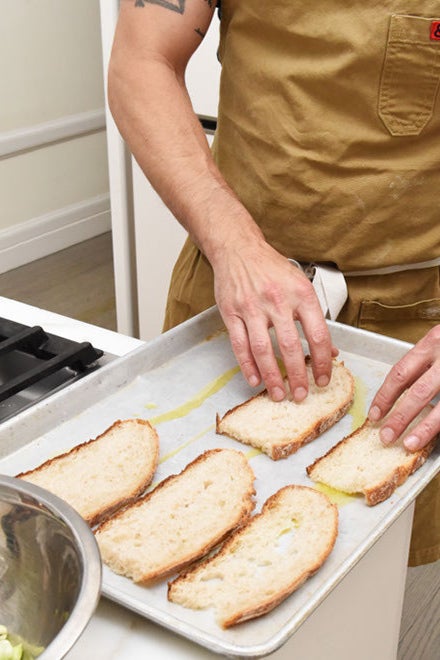
14. The pancetta is done when it's browned and crispy and most of the fat has rendered out, about 10-12 minutes.

15. Raise the oven temperature to 400°F and toast the bread until it's crispy and very browned.

16. While the bread is toasting, break the pancetta into pieces roughly 3-4 inches long, and put the pieces in the bowl with the fava beans.
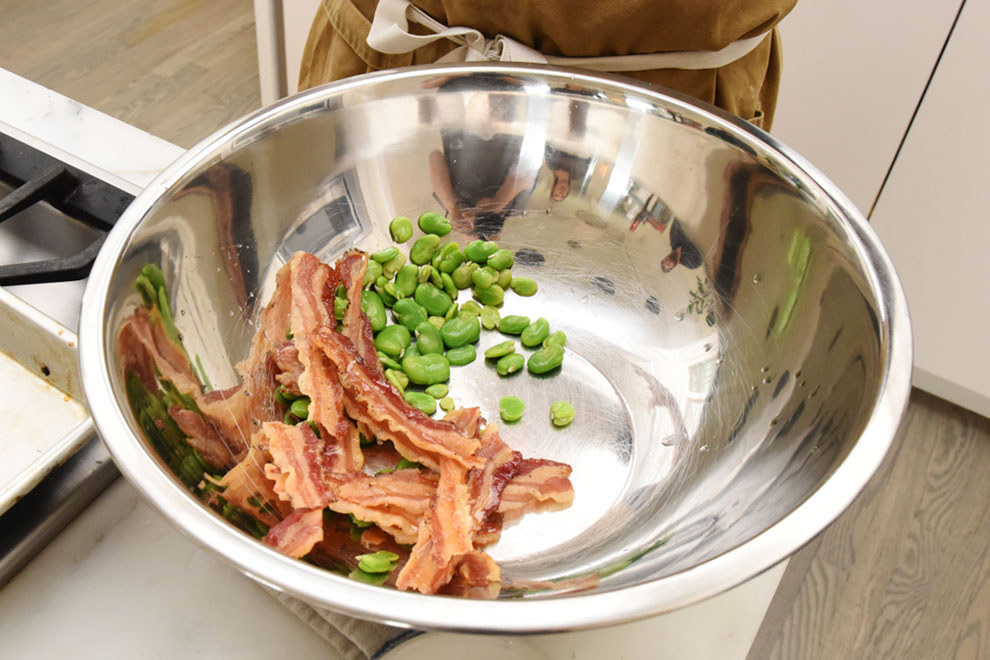
17. Roughly tear about 1/4 cup of parsley leaves off of a bunch of parsley, then add them to the mixing bowl.


"I'm really into parsley as a salad green," Acheson says. "It's really cheap and really tasty."
18. Take the stems of the parsley that you ripped the leaves off of, and thinly slice enough of them to yield about 2 tablespoons.


19. Add a tablespoon of sherry vinegar and a tablespoon of olive oil.
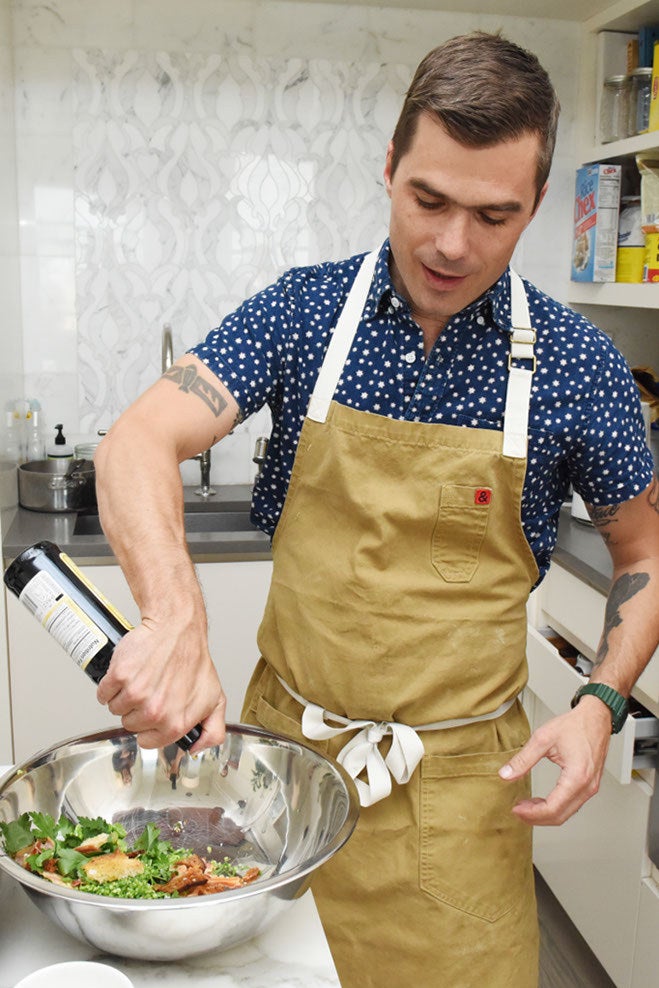

20. Season with sea salt, to taste, and toss to combine everything.
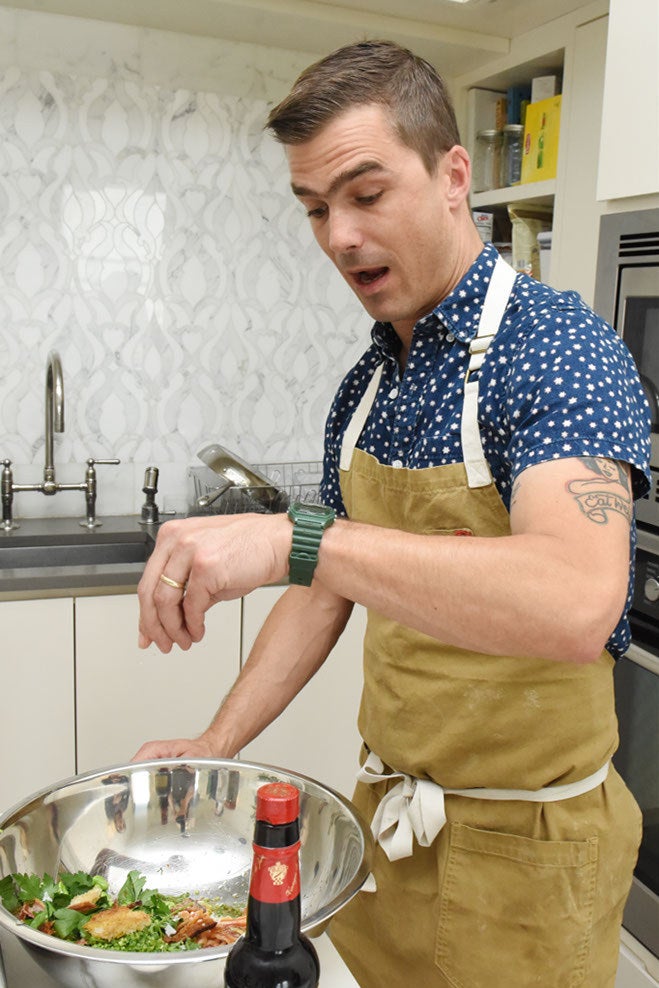
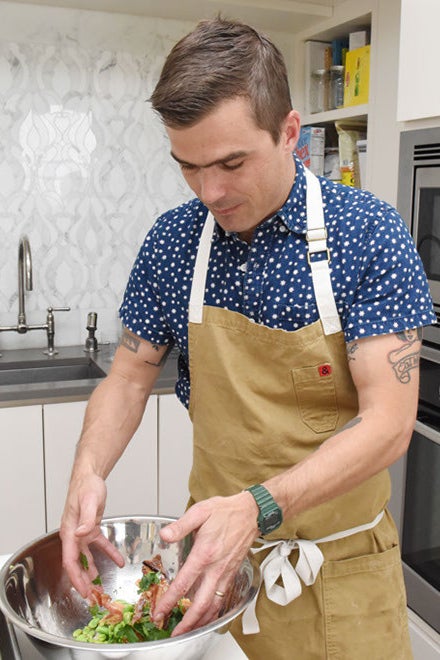
21. Divide the mixture among the four pieces of toast, each on separate plates.

22. To poach the eggs, fill a medium skillet or saucepan about 3/4 of the way with water.
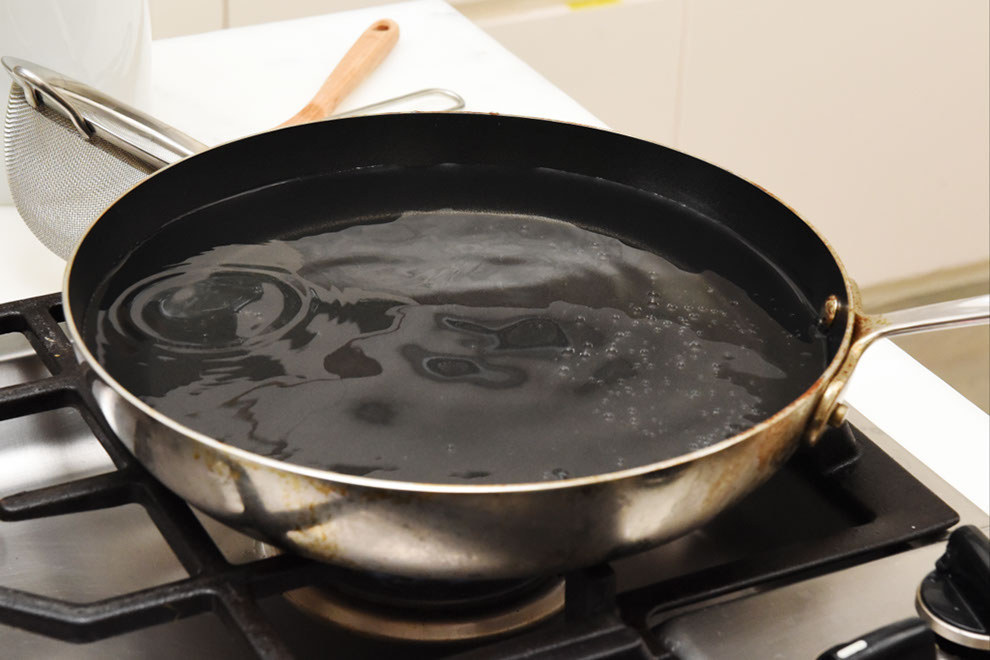
23. Bring the water to a simmer, then add a tablespoon of sea salt and a tablespoon of white vinegar.


24. Lower the heat to below a simmer, so that it's trembling but not bubbling. Use a large spoon to create a very gentle whirlpool.
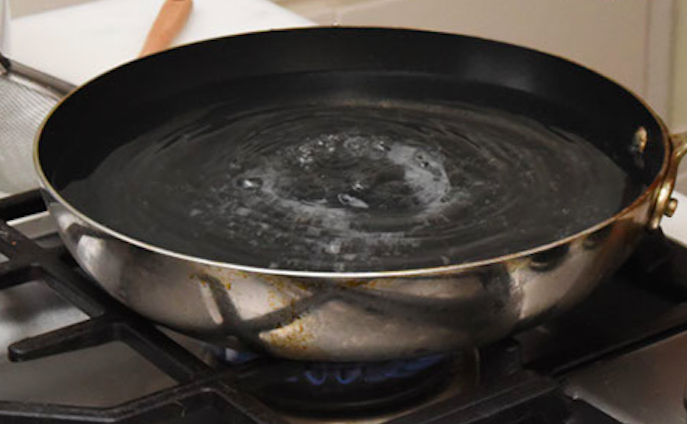
CHEF'S TIP:
"Just a light whirlpool is fine. The egg will gather together as it cooks a little bit, and the loose stuff will come off." So, don't worry about white bits detaching from the egg and floating around in the water; there's still plenty of white to hold the egg together.
25. Crack the eggs into individual ramekins or small bowls.
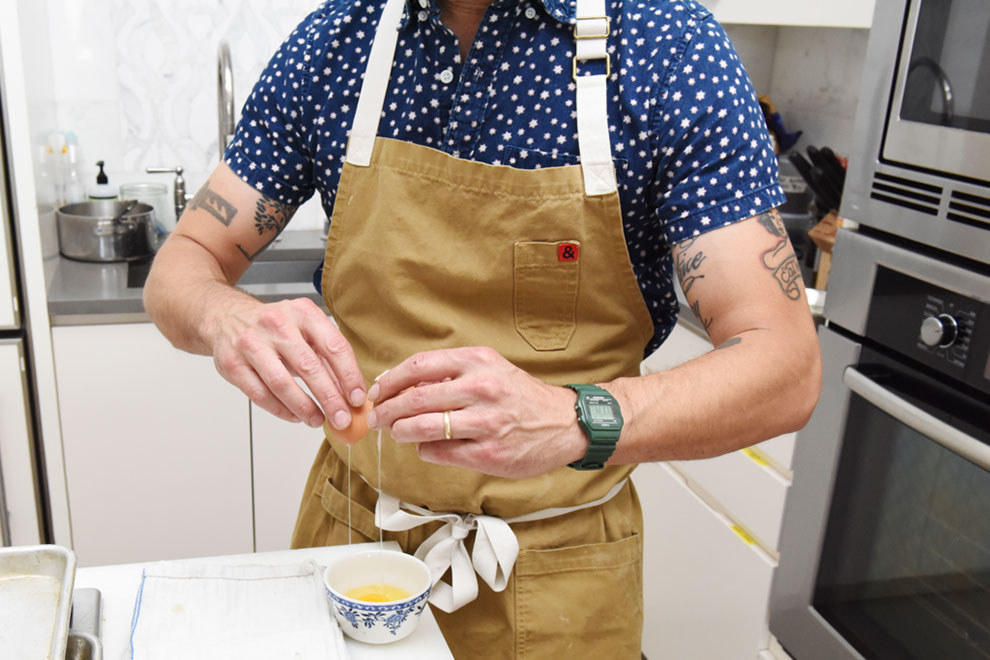
26. Drop the eggs into the water one at a time by lowering the ramekins all the way down to the water's surface and gently sliding the egg in.
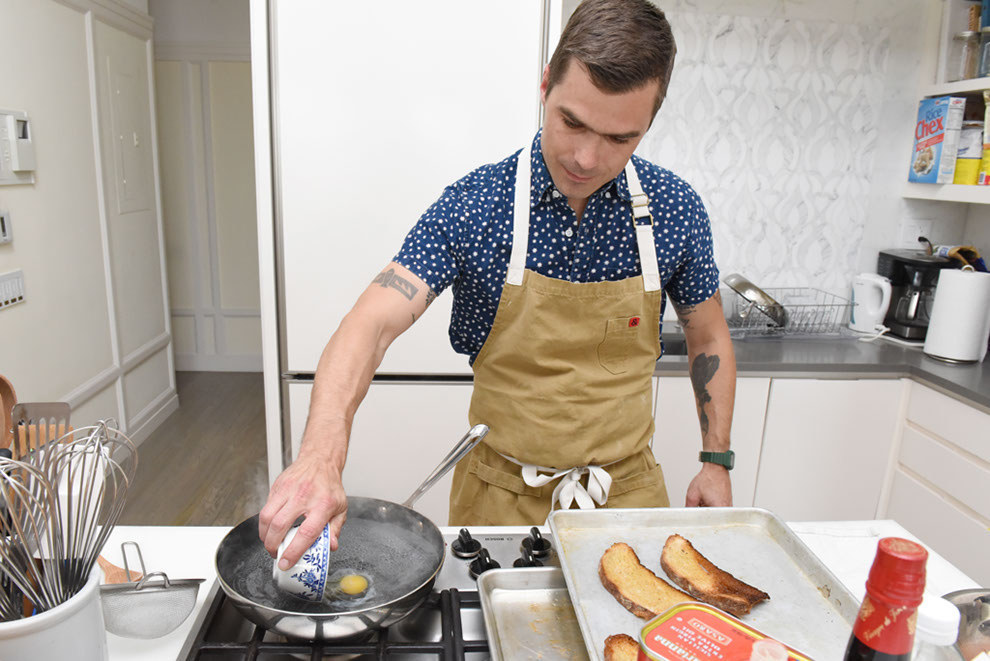
27. Repeat with the other eggs.
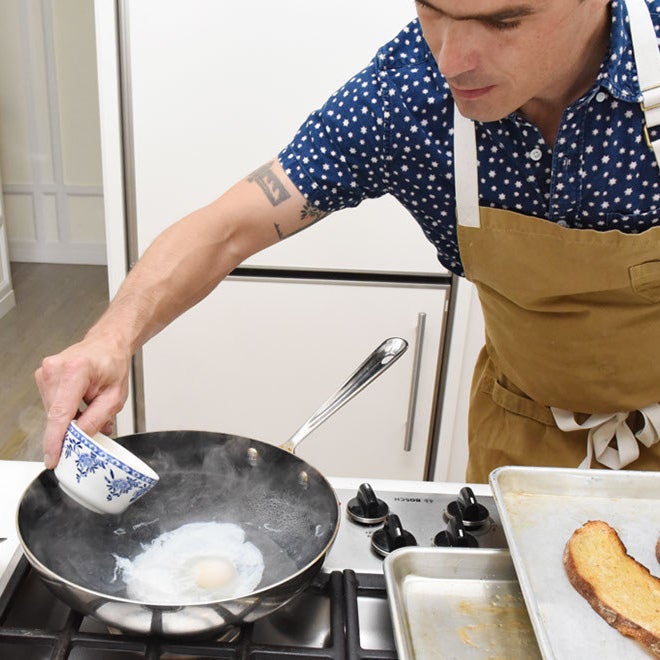

If you can't fit all four at once, you can work in two batches. Note that you don't need that much space for each egg, though. They'll wrap around themselves pretty quickly.
28. Let the eggs sit in the 165°F - 170°F water for exactly four minutes, then use a spoon (preferably a slotted spoon) to gently lift them out one at a time.
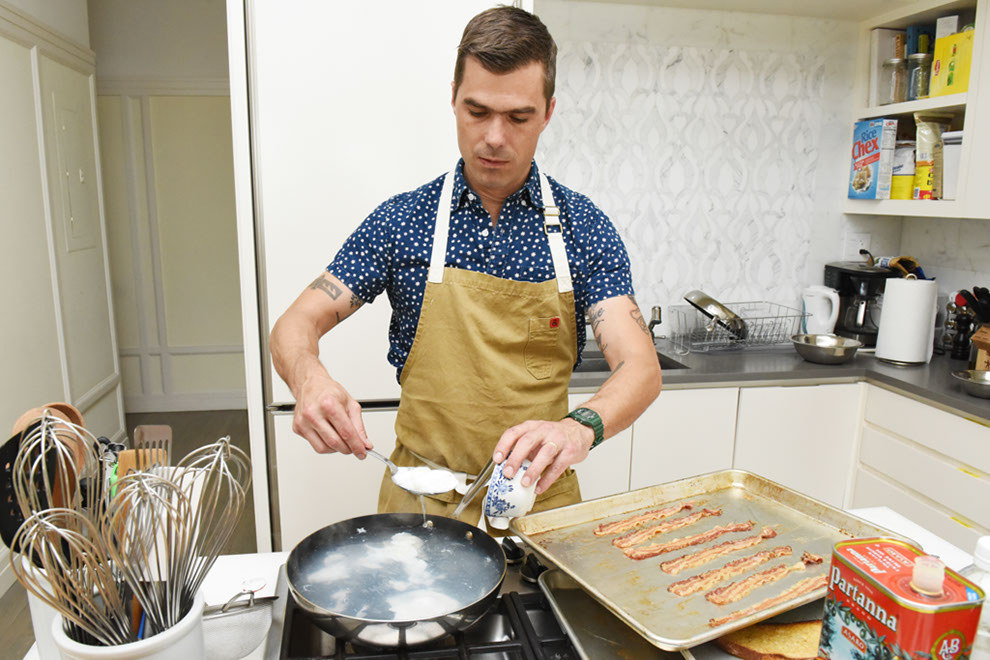
29. Gently spoon the egg on top of the vegetable and pancetta mixture on toast, and finish with a sprinkle of sea salt.
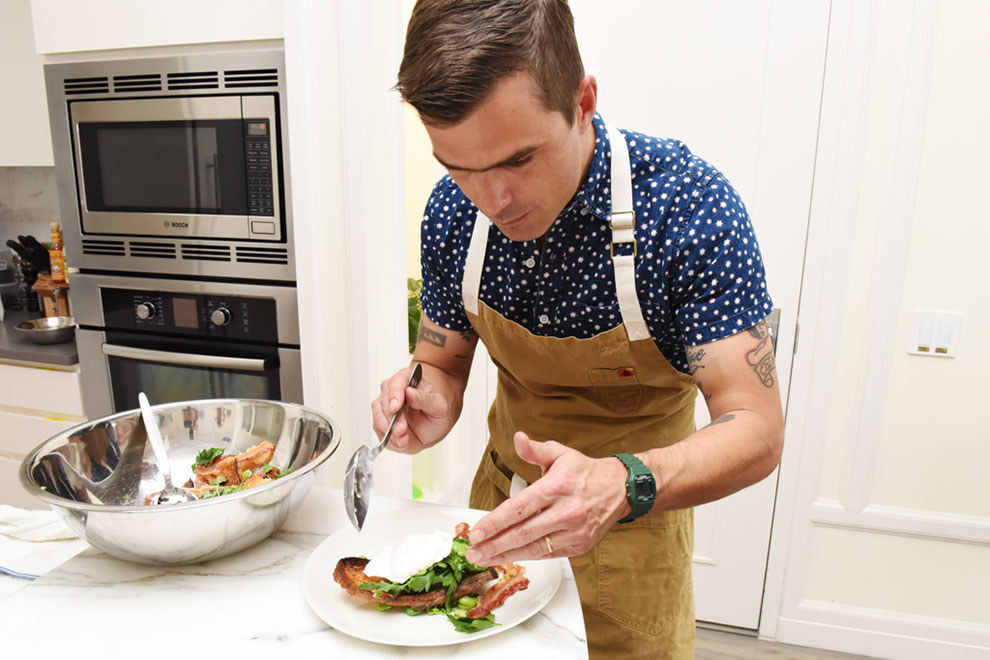
30. Garnish with as much additional pancetta as you can.
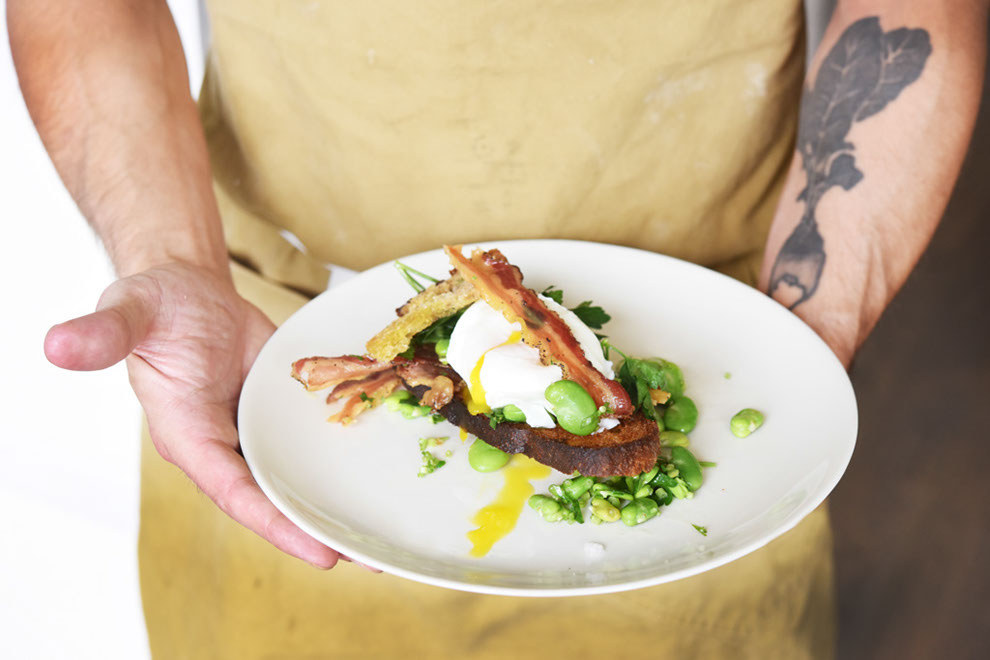
Devour.
Fava Beans, Poached Egg, and Pancetta on Toast
Serves 4
Recipe by Hugh Acheson
INGREDIENTS
Sea salt
1 pound fava beans in the pods
1/2 pound thinly sliced pancetta
4 long, thin s lices of focaccia or sourdough bread
2 tablespoons olive oil, divided
1 tablespoon sherry vinegar
2 tablespoons thinly sliced fresh parsley stems
1/4 cup parsley leaves
1 tablespoon distilled white vinegar
4 large eggs, at room temperature
PREPARATION
1. Preheat the oven to 350°F. Make sure your eggs are sitting out on the counter; they'll poach more quickly that way.
2. Prepare an ice water bath by filling a medium or large mixing bowl 3/4 of the way full with half water and half ice. Set the ice bath on the counter near the stove.
3. Fill a large saucepan 3/4 of the way with water, season the water with 1-2 tablespoons of sea salt, then bring it to a boil over high heat.
4. While the water heats, remove the fava beans from their pods by breaking the pods open down the center, lengthwise, and scraping out the beans. Discard the pods. Add the shelled favas to the boiling water and blanch them for 1 minute, until they are bright green in the center (test this by taking one out and peeling off the outer shell) and just barely cooked, still crisp and al dente in texture. Drain the fava beans and immediately drop them into the ice water. Allow them to cool in the ice water for at least 2 minutes, then peel away, remove, and discard their outer skins (see photos above).
5. Place the slices of pancetta in a single layer on a rimmed baking sheet, then bake in the preheated oven until the fat has rendered out and the edges are golden and crisp, 10-12 minutes. When the pancetta is cooked, gently transfer it to a paper towel-lined plate and allow it to cool.
6. Raise the oven temperature to 400°F and drizzle the baking sheet with a tablespoon of olive oil. Lay the foccacia out in a single layer, and toast in the oven until it's crisp and browned, about 6 minutes.
7. Break the cooked pancetta into pieces 3-4 inches long, and combine the pancetta, fava beans, sherry vinegar, parsley stems, parsley leaves, and the remaining tablespoon of olive oil in a medium mixing bowl. Season with sea salt to taste and toss well.
8. Arrange the toasts on a serving platter or individual plates, then divide the fava bean salad among the toasts. Arrange the pancetta on top, and set the toasts aside while you poach the eggs.
9. To poach the eggs: Crack the eggs into individual ramekins (or small bowls, teacups, or mugs). Fill a medium saucepan about 3/4 of the way with water (you want the water to be at least 2.5 inches deep). Bring the liquid to a boil and add one tablespoon of sea salt and the distilled white vinegar. Reduce the heat to just below a simmer, so it's trembling but not bubbling. This will be 165° to 170°F; if you have a thermometer, take the temperature to be sure. Swirl the water gently a few times with a large spoon. While the water is still swirling around, gently pour each egg into the water, one by one. Let the eggs sit in the water for exactly 4 minutes for set whites and soft yolks. If you want the yolks firmer, let the eggs poach for an additional minute or two. When they're done, use a spoon to gently lift the eggs out of the water and onto each the toasts, being careful not to spoon extra water on the toasts with the eggs (a slotted spoon works best).
10. Sprinkle the eggs with sea salt and serve immediately.

There are more delicious, seasonal recipes like this one in Acheson's new cookbook, The Broad Fork.

